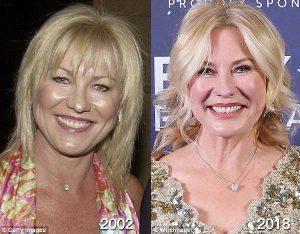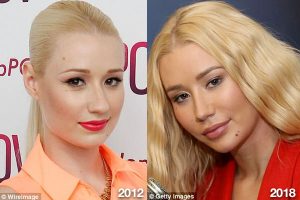In 2011, total cosmetic procedures as reported to the American Society of Plastic Surgeons have increased by 5%. While the majority of that rise has been attributed to the increasing use of noninvasive treatments which include Botox, lasers and fillers, actual surgical procedures have decreased somewhat. This may be more reflective of a rather anemic economy than an actual trend per se. Soft tissue fillers like Hyaluronic acid (Restylane®, Juvederm Ultra®, etc.), calcium hydroxyapatite (Radiesse®), and fat injections experienced some of the largest growth in the minimally-invasive market during 2011. More than 1.3 million hylauronic acid procedures were performed in 2011, up 9 percent; 286,000 calcium hydroxyapatite procedures, up 36 percent; and 68,000 fat injections, up 19 percent. However, in my practice I have noticed a shift back towards surgical procedures such as facelifts-perhaps this is because seasoned, sophisticated patients have come to realize firsthand the limitations of noninvasive treatments.
With the ever expanding embrace of fillers by the population, people are increasingly equating them to a manicure and pedicure. Doctors, Nurses and patients alike rarely think twice about their application and often times are not aware of their potentially serious risks. However, even a recent study has shown that seven out of 10 British doctors have experienced complications with the use of fillers (
http://www.inquisitr.com/432110/wrinkles-dermal-fillers-can-cause-blue-skin-and-blindness-report/).
Among the fillers approved for use within the United States include many hyaluronic acids-HA (Juvéderm®, Restyane®, Perlane®, etc.), calcium hydroxyapatite (Radiesse®), PMMA (Artefill®), Sculptra® and fat. The HA’s are associated with their own unique side effects such as the Tyndall effect (a bluish gray swelling that imparts a puffy look to the lower eyes) while Radiesse®, Sculptra® and Artefill® can induce granulomas. However,
all of these fillers have been associated with a few extremely rare but potentially devastating complications. Among these are skin necrosis (death of soft tissue) and vision loss. These problems result from a highly unlikely, unforeseen introduction of a minuscule amount of material into a microscopic branch of a facial blood vessel. A very small amount of filler injected into a peripheral vessel around the forehead, nose, nasolabial fold and even lip can result in these aforementioned complications. It is important to note that not only filler, but fat from a facial fat transfer and even a simple steroid injection have been implicated in both tissue and vision loss.
Once in the bloodstream, the filler in turn can travel downstream through the labyrinth of interconnecting blood vessels and if, in the highly unlikely event, it makes a wrong turn, it can end up in one of the blood vessels supplying the retina of the eye. Recently, I was devastated to discover that a patient of mine suffered one sided vision loss because of this very issue. Ironically, she showed no signs of external injury and still appears as a beautiful woman. A few ways for doctors to diminish the chances of such terrible occurrences are to use blunt tip cannulas instead of sharp-tipped needles whenever possible and to inject small amounts while withdrawing the syringe. Though I employ these two techniques routinely even under magnification, there is no absolute guarantee that these complications can be avoided. It is important that patients are made aware of these risks, albeit fleetingly small, in order that they can make an informed decision as to whether to proceed.
“We cannot estimate the incidence of these devastating complications among recipients to filler injections. It must be extremely rare, but it does happen,” Dr. Woo from Seoul National University’s Bundang Hospital told
Medscape Medical News. The likelihood of such a devastating event is probably less than being struck by lightning
| Odds of being struck by lightning in a given year (reported deaths + injuries) 1/1,000,000 |
|
| Odds of being struck by lightning in a given year (estimated total deaths + injuries) 1/775,000 |
|
| Odds of being struck in your lifetime (Est. 80 years) 1/10,000 |
|
and certainly less than being injured in a car accident. Even though we are aware of the risks of driving and probably know a few people may have been seriously injured or even killed in a motor vehicle accident, few of us think twice about getting into a an automobile, turning on its ignition and driving.
A good summary of this tragic problem written from an objective standpoint can be accessed here
http://www.lipostructure.com/wp-content/uploads/2012/08/Avoidence.pdf
R.D. Haworth M.D., F.A.C.S.
Ironically, two weeks after I wrote this blog, I was involved in a motor vehicle accident (1 week ago, today being March 12, 2013). Fortunately, no one was seriously injured.
 ‘There is no disputing that Blair had her breasts enhanced, most likely with the help of a plastic surgeon. Her results make quite the statement and leave little to the imagination,’ Dr. Haworth observed. ‘The abrupt edge of her breasts as they transition from her chest wall indicate to me she had breast implants likely placed over her pectoralis major muscle,’ Dr. Haworth claimed.
‘There is no disputing that Blair had her breasts enhanced, most likely with the help of a plastic surgeon. Her results make quite the statement and leave little to the imagination,’ Dr. Haworth observed. ‘The abrupt edge of her breasts as they transition from her chest wall indicate to me she had breast implants likely placed over her pectoralis major muscle,’ Dr. Haworth claimed.

 ‘Mrs Kennerley looks better than ever compared to her former self 15 years ago. Though maintaining a healthy lifestyle and weight certainly helps, based on recent photographs, I feel that she enlisted the expertise of a plastic surgeon along the way’, Haworth told Daily Mail Australia this week. Dr. Haworth went on to speculate that Kerri-Anne has used dermal fillers to maintain her youthful complexion.
‘Mrs Kennerley looks better than ever compared to her former self 15 years ago. Though maintaining a healthy lifestyle and weight certainly helps, based on recent photographs, I feel that she enlisted the expertise of a plastic surgeon along the way’, Haworth told Daily Mail Australia this week. Dr. Haworth went on to speculate that Kerri-Anne has used dermal fillers to maintain her youthful complexion. ‘When done right, results can be sublime and indiscernible to a layman’s eye. In the absence of rare complications, less surgical work is needed to create the beautiful, yet subtle, results as exemplified by Ms Azalea – while a less-than-average surgeon could draw unwanted attention to an anatomical “flaw” which only makes things worse.’
‘When done right, results can be sublime and indiscernible to a layman’s eye. In the absence of rare complications, less surgical work is needed to create the beautiful, yet subtle, results as exemplified by Ms Azalea – while a less-than-average surgeon could draw unwanted attention to an anatomical “flaw” which only makes things worse.’










